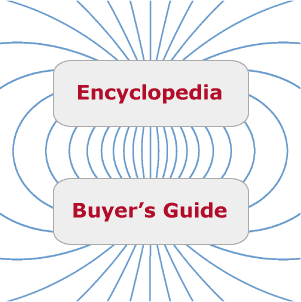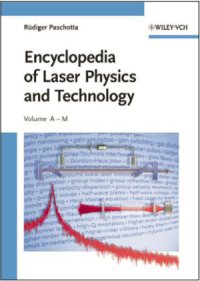The RP Photonics Encyclopedia
(formerly the Encyclopedia of Laser Physics and Technology) is a large scientifically founded encyclopedia on optics and photonics, which serves both scientific researchers and industrial professionals worldwide:
- 948 comprehensive encyclopedia articles on optics and photonics, optoelectronics, quantum optics, fiber optics, light pulses, laser technology, gas discharge lamps, lightwave communications, spectroscopy and optical metrology – the largest and most popular photonics encyclopedia worldwide
- freely available online (open access, no registration, completely anonymous use), and since 2008 as a two-volume book, published via Wiley-VCH

- connected with the RP Photonics Buyer's Guide: find suppliers for hundreds of photonics products and make well informed purchase decisions
- related blog: the Photonics Spotlight, also available as a newsletter
- also offers a glossary of photonics terms, articles grouped by categories and the Photonics Quiz
This extremely popular website (typically around 200,000 page views per month, mostly on the encyclopedia) provides excellent opportunities for advertising: Buyer's Guide entries, banners, special promotions – use it for your photonics marketing! Besides, you may become a sponsor of our encyclopedia.
New feature for all encyclopedia and blog articles: If you have a good question or comment – something fundamental, of general interest – you can enter it in the box for questions and comments below the article.
The Photonics Community is Learning Here

This comprehensive open-access encyclopedia, authored by Dr. Rüdiger Paschotta and provided by RP Photonics Consulting GmbH, covers much of the areas of optics and photonics. Further below you find a list of examples, demonstrating the coverage of the field.
The encyclopedia huge – by now containing 948 full articles – not only definitions as in a dictionary or a glossary. Substantial work has been invested and is further invested to provide all information with advanced textbook quality. With this work, RP Photonics provides a much appreciated service to both the photonics industry and the academic community. Many references to selected scientific articles and textbooks aid further studies.
The consistent quality of this resource is widely acknowledged in the field. This concerns the technical and scientific content, making it highly useful for professional work, but also many other aspects. For example, the website is designed for easy reading and has a clear navigation structure. It allows for advertising, but never in an intrusive way and without ever diminishing user privacy. Its clean and well tested code provides a fast response and is highly secure against hacker risks. It received security grade A+ at Mozilla Observatory.
The encyclopedia is freely accessible via this website – without registration, and with full privacy. (You can use it with complete anonymity.) Huge numbers of professionals worldwide, working either in the photonics industry or in scientific research, use this resource on a regular basis.
An early version of the encyclopedia has become available as a two-volume book, published via Wiley-VCH in 2008.
Since 2012, the encyclopedia is intimately linked with the RP Photonics Buyer's Guide, a resource for finding suppliers of optics and photonics products. The combination of encyclopedia and buyer's guide is ideal for users making informed purchase decisions, and it also provides excellent opportunities for the marketing of photonics products.
Dr. Rüdiger Paschotta, the author of the encyclopedia, offers a broad range of consulting services in topical areas like lasers, amplifiers, nonlinear optics and fiber optics via RP Photonics. His competence is available for development projects, or for tailored staff training courses performed at the customer's location. Also, he has developed powerful simulation software for work in laser technology, fiber optics and thin-film optics.
Related Pages
Besides the encyclopedia articles, there are related pages, which you can reach via the menu on the top of this page:
- Grouping of the articles into topical categories
- Glossary of photonics terms and list of formula symbols
- RP Photonics Buyer's Guide, the ideal place for informing experts on photonics products
- The Photonics Spotlight is a blog with interesting news in photonics and laser technology (also available as a newsletter). The latest articles:
- Time to Start Digital Marketing with RP Photonics – with a Discount
- Digital and Interactive Methods of Supporting the Photonics Industry
- Photonics Marketing in Times of the Coronavirus Crisis
- Laser Physics Helps to Understand the Corona Virus Crisis
- News on the RP Photonics Website
- Why Are Large Mode Areas Problematic?
- Can Monochromatic Light be Unpolarized?
- New Articles in the RP Photonics Encyclopedia
- The Relevance of Photonics Buyer's Guides for Users and Advertisers
- Resonator Modes in Microchip Lasers
- The Photonics Quiz with a number of questions on lasers and related areas
- Opportunities for advertising in the encyclopedia
- Suggestions concerning the use of the encyclopedia
- Hints for making links on your own web page and for citing encyclopedia articles
- Feedback: send comments and suggestions to RP Photonics
Examples for Available Articles in Various Topical Areas
Here you can get an overview on the topics which are covered by this encyclopedia. Note that these are only examples; in total we have 948 encyclopedia articles.
- General optics: geometrical optics, imaging, optical aberrations, entrance and exit pupil, Kramers–Kronig relations, Fourier spectrum, Gaussian beams, Hermite–Gaussian modes, Gouy phase shift, beam quality, brightness, optical resonators, waveguide dispersion, finesse, coherence, phase velocity and group velocity, superluminal transmission and causality, color vision
- Optical instruments and devices: photo cameras, loupes, microscopes, telescopes, interferometers, Bragg mirrors, beam shapers, optical filters, electro-optic modulators, acousto-optic modulators, optical tweezers, arrayed waveguide gratings, integrating spheres, mode cleaner cavities, Lyot filters, optical spectrum analyzers

- Optoelectronics: photodiodes, avalanche photodiodes, phototransistors, photocathodes, photomultipliers, photon counting, laser diodes, quantum cascade lasers, light-emitting diodes, superluminescent diodes, photonic integrated circuits, silicon photonics, electroabsorption modulators, opto-isolators, image sensors
- Nonlinear optics: nonlinear crystal materials, intracavity or resonant frequency doubling, sum and difference frequency generation, optical parametric oscillators, parametric generators and amplifiers, Brillouin and Raman scattering, self- and cross-phase modulation, four-wave mixing, quasi-phase matching
- Fiber optics: high power fiber lasers and amplifiers, Raman amplifiers, single-mode and multi-mode fibers, rare-earth-doped fibers, double-clad fibers, dispersion-shifted fibers, photonic crystal fibers, fiber Bragg gratings, adiabatic soliton compression, nonlinear polarization rotation
- Lasers and amplifiers: laser design and development, laser resonators, fiber-coupled diode lasers, diode-pumped lasers, fiber lasers, erbium-doped amplifiers, laser and amplifier noise, power scaling, upconversion lasers, amplified spontaneous emission, beam pointing fluctuations, spatial hole burning, relaxation oscillations, red, green and blue lasers, cryogenic lasers, laser modeling, laser safety
- Non-laser light sources: gas discharge lamps, arc and flash lamps, fluorescent lamps, mercury vapor lamps, metal halide lamps, high intensity discharge lamps, xenon lamps, sodium vapor lamps, superluminescent sources
- Light pulses: bandwidth-limited pulses, parabolic pulses, mode-locked lasers, additive-pulse mode locking, regenerative amplifiers, chirped-pulse amplification, transform limit, pulse characterization, time–bandwidth product, frequency combs, timing jitter, parabolic pulses, Q-switched lasers
- Optical communications: optical fiber communications, fiber-optic links and networks, telecom windows, free-space optical communications, space division multiplexing, amplifier noise, bit error rate, bandwidth–distance product, optical modulators, photonic integrated circuits
- Optical spectroscopy: laser absorption spectroscopy, time-resolved spectroscopy, Raman spectroscopy, multipass gas cells, spectrometers, spectrophotometers, tunable lasers, mid-infrared laser sources
- Quantum optics and quantum effects: squeezed states of light, Glauber states, quantum wells, quantum dots, light forces, laser cooling, quantum noise, shot noise, Schawlow–Townes linewidth, quantum cryptography
- Noise in optics: noise specifications, power spectral density, timing jitter, Gordon–Haus jitter, quantum noise, squeezed states of light, standard quantum limit, shot noise, relative intensity noise, phase noise, noise eaters, linewidth, stabilization of lasers
The Latest Encyclopedia Articles
This encyclopedia is not a static resource, but is constantly further extended to cover more topics and more details. Here you find the latest articles:
We also offer an ![]() RSS-Feed for new articles.
RSS-Feed for new articles.
Some Random Selection of Articles
Here are some randomly selected articles – just to make you curious:
- gain switching
- optical delay lines
- gradient-index lenses
- beam radius
- few-mode fibers
- homogeneous broadening
- parabolic pulses
- optical flats
- high harmonic generation
- signal lamps
- McCumber theory
- high-power fiber lasers and amplifiers
- beam divergence
- coherence
- non-radiative transitions
- metastable states
- laser optics
- dye lasers
- spectral brightness
- group delay dispersion
Note that articles from the Photonics Spotlight and the RP Software News are not listed here; check them separately!






